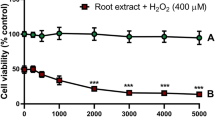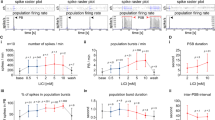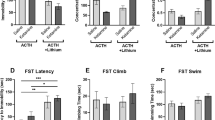Abstract
The present study was undertaken to determine whether lithium addition to long-term treatment with different classes of antidepressant drugs could induce a greater effect on the serotonin (5-HT) system than the drugs given alone. Because 5-HT1A receptor activation hyperpolarizes and inhibits the firing activity of CA3 pyramidal neurons in the dorsal hippocampus, the degree of disinhibition produced by the selective 5-HT1A receptor antagonist WAY 100635 was determined using in vivo extracellular recordings. In controls, as well as in rats receiving a lithium diet for 3 days, the administration of WAY 100635 (25-100 μg/kg, IV) did not modify the firing activity of dorsal hippocampus CA3 pyramidal neurons. When the tricyclic antidepressant imipramine (10 mg/kg/day, SC), the monoamine oxidase inhibitor tranylcypromine (2.5 mg/kg/day, SC) and the selective 5-HT reuptake inhibitor paroxetine (10 mg/kg/day, SC) were administered alone for 21 days, a dose of 50 μg/kg of WAY 100635 was needed to increase significantly the firing activity of these neurons. On the other hand, WAY 100635, at a dose of only 25 μg/kg, increased significantly the firing rate of CA3 pyramidal neurons in rats receiving both a long-term antidepressant treatment and a short-term lithium diet. It is concluded that the addition of lithium to antidepressant treatments produced a greater disinhibition of dorsal hippocampus CA3 pyramidal neurons than any treatments given alone. The present results support the notion that the addition of lithium to antidepressants may produce a therapeutic response in treatment-resistant depression by enhancing 5-HT neurotransmission.
Similar content being viewed by others
Log in or create a free account to read this content
Gain free access to this article, as well as selected content from this journal and more on nature.com
or
References
Baptista TJ, Hernandez L, Burguera JL, Burguera M, Hoebel BG . (1990): Chronic lithium administration enhances serotonin release in the lateral hypothalamus but not in the hippocampus. A microdialysis study. J Neural Trans 82: 31–41
Beck SG . (1992): 5-Hydroxytryptamine increases excitability of CA1 hippocampal pyramidal cells. Synapse 10: 334–340
Beck SG, Bacon WL . (1998): 5-HT7 receptor mediated inhibition of sAHP in CA3 hippocampal pyramidal cells. Soc Neurosci Abst 24: 435.4
Bel N, Artigas F . (1992): Fluvoxamine preferentially increases extracellular 5-hydroxytryptamine in the raphe nuclei: An in vivo microdialysis study. Eur J Pharmacol 229: 101–103
Besson A, Haddjeri N, Debonnel G, Blier P, de Montigny C . (1997): Effects of the combination of mirtapine and paroxetine on the 5-HT neurotransmission. Soc Neurosci Abst 23: 485.3
Bitsch Jensen J, Mørk A . (1997): Altered protein phosphorylation in the rat brain following chronic lithium and cabamazepine treatments. Eur Neuropsychopharmacol 7: 173–179
Blier P, Bouchard C . (1994): Modulation of 5-HT release in guinea pig brain following long-term administration of antidepressant drugs. Brit J Pharmacol 113: 485–495
Blier P, de Montigny C . (1985): Short-term lithium administration enhances serotonergic neurotransmission: Electrophysiological evidence in the rat CNS. Eur J Pharmacol 113: 69–77
Blier P, de Montigny C, Azzaro AJ . (1986): Modification of serotoninergic and noradrenergic neurotransmission by repeated administration of monoamine oxidase inhibitors: Electrophysiological studies in the rat central nervous system. J Pharmacol Exp Ther 237: 987–994
Blier P, de Montigny C . (1987): Modification of 5-HT neuron properties by sustained administration of the 5-HT1A agonist gepirone: Electrophysiological studies in the rat brain. Synapse 1: 470–480
Blier P, de Montigny C . (1994): Current advances and trends in the treatment of depression. Trends Pharmacol Sci 15: 220–225
Blier P, de Montigny C, Tardif D . (1987): Short-term lithium treatment enhances responsiveness of postsynaptic 5-HT1A receptors without altering 5-HT autoreceptor sensitivity: An electrophysiological study in the rat brain. Synapse 1: 225–232
Blier P, Lista A, de Montigny C . (1993): Differential properties of pre- and postsynaptic 5-hydroxytryptamine1A receptors in dorsal raphe and hipocampus: I. Effect of spiperone. J Pharmacol Exp Ther 265: 7–15
Chaput Y, de Montigny C . (1988): Effects of the 5-HT1 receptor antagonist BMY 7378 on the 5-HT neurotransmission: Electrophysiological studies in the rat central nervous system. J Pharmacol Exp Ther 246: 359–370
Chaput Y, de Montigny C, Blier P . (1986): Effects of a selective 5-HT reuptake blocker, citalopram, on the sensitivity of 5-HT autoreceptors: Electrophysiological studies in the rat brain. Naunyn-Schmiedeberg's Arch Pharmacol 33: 342–348
Chaput Y, de Montigny C, Blier P . (1991): Presynpatic and postsynaptic modifications of the serotonin system by long-term antidepressant treatments: Electrophysiological studies in the rat brain. Neuropsychopharmacology 5: 219–229
Cummings JL . (1993): The neuroanatomy of depression. J Clin Psychiat 543: 14–20
de Montigny C . (1984): Electroconvulsive treatments enhance responsiveness of forebrain neurons to serotonin. J Pharmacol Exp Ther 228: 230–234
de Montigny C, Aghajanian GK . (1978): Tricyclic antidepressants: Long-term treatment increases responsivity of rat forebrain neurons to serotonin. Science 202: 1303–1306
de Montigny C, Grunberg F, Mayer A, Deschesne JP . (1981): Lithium induces rapid relief of depression in tricyclic antidepressant drug nonresponders. Brit J Psychiat 138: 252–256
de Montigny C, Cournoyer G, Morissette R, Langlois R, Caille G . (1983): Lithium carbonate addition to tricyclic antidepressant-resistant depression. Correlations with neurobiologic actions of tricyclic antidepressant drugs and lithium ion on the serotonin system. Arch Gen Psychiat 40: 1327–1334
Dixon JF, Hokin LE . (1997): The antibipolar drug valproate mimics lithium in stimulation glutamate release and inositol 1,4,5-trisphosphate accumulation in brain cortex slices but not accumulation of inositol monophosphates and biphosphates. Proc Natl Acad Sci USA 94: 4757–4760
Dixon JF, Hokin LE . (1998): Lithium acutely inhibits and chronically up-regulates and stabilizes glutamate uptake by presynaptic nerve endings in mouse cerebral cortex. Proc Natl Acad Sci USA 95: 8363–8368
Dixon JF, Los GV, Hokin LE . (1994): Lithium stimulates glutamate release and inositol 1,4,5-trisphosphate accumulation via activation of N-methyl-D-aspartate receptor in monkey and mouse cortex slices. Proc Natl Acad Sci USA 91: 8358–8362
Ferrer A, Artigas P . (1994): Effects of single and chronic treatment with tranylcypromine on extracellular serotonin in rat brain. Eur J Pharmacol 263: 227–234
Fletcher A, Forster EA, Bill DJ, Brown G, Cliffe IA, Hartley JE, Jones DE, McLenachan A, Stanhope KJ, Critchley DJ, Childs KJ, Middlefell VC, Lanfumey L, Corradetti R, Laporte AM, Gozlan H, Hamon M, Dourish CT . (1996): Electrophysiological, biochemical, neurohormonal, and behavioral studies with WAY-100635, a potent, selective, and silent 5-HT1A receptor antagonist. Behav Brain Res 73: 337–353
Fornal CA, Metzler CW, Gallegos RA, Veasey SC, McCreary AC, Jacobs BL . (1996): WAY 100635, a potent and selective 5-hydroxytryptamine1A antagonist, increases serotonergic neuronal activity in behaving cats: Comparison with (S)-WAY-100135. J Pharmacol Exp Ther 278: 752–762
Forster EA, Cliffe IA, Bill DJ, Dover GM, Jones D, Reilly Y, Fletcher A . (1995): A pharmacological profile of the selective silent 5-HT1A receptor antagonist, WAY 100635. Eur J Pharmacol 281: 81–88
Gartside SE, Umbers V, Hajos M, Sharp T . (1995): Interaction between a selective 5-HT1Areceptors antagonist and an SSRI in vivo: Effects on 5-HT cell firing and extracellular 5-HT. Brit J Pharmacol 115: 1064–1070
Goodnough DB, Baker GB . (1994) Comparisons of the actions of high and low doses of the MAO inhibitor tranycyl-promine on 5-HT2 binding sites in the rat cortex. J Neural Transm 41: 127–134
Goodwin GM . (1989): The effects of antidepressant treatment and lithium upon 5-HT1A receptor function. Prog Neuro-Psychopharmacol Biol Psychiat 13: 445–451
Goodwin GM, De Souza RJ, Wood AJ, Green AR . (1986): The enhancement by lithium of the 5-HT1A mediated serotonin syndrome produced by 8-OH-DPAT in the rat: Evidence for a postsynaptic mechanism. Psychopharmacology 90: 488–493
Grahame-Smith DG, Green AR . (1974): The role of brain 5-hydroxytryptamine in the hyperactivity produced by lithium and monoamine oxidase. Brit J Pharmacol 52: 19–26
Haddjeri N, Blier P, de Montigny C . (1997): Effects of long-term treatment with the α2-adrenoreceptor antagonist mirtazapine on 5-HT neurotransmission. Naunyn-Schmiedeberg's Arch Pharmacol 355: 20–29
Haddjeri N, Blier P, de Montigny C . (1998a): Long-term antidepressant treatments result in a tonic activation of forebrain 5-HT1A receptors. J Neurosci 19: 10150–10156
Haddjeri N, de Montigny C, Curet O, Blier P . (1998b): Effect of the reversible monoamine oxidase-A inhibitor befloxatone on the rat 5-HT neurotransmission. Eur J Pharmacol 343: 179–192
Heninger GR, Charney DS . (1987): Mechanisms of action of antidepressant treatments: Implications for the etiology and treatment of depression disorders. In Meltzer HY (ed), Psychopharmacology: The Third Generation of Progress. New York: Raven, pp 535–544
Hotta I, Yamawaki S . (1988): Possible involvement of presynaptic 5-HT autoreceptors in effect of lithium on 5-HT release in hippocampus of rat. Neuropharmacology 27: 987–992
Jope RS, Williams MB . (1994): Lithium and brain signal transduction systems. Biochem Pharmacol 47: 429–441
Kandel ER, Spencer WA . (1961): Electrophysiology of hippocampal neurons. II. After-potentials and repetitive firing. J Neurophysiol 24: 243–259
Karoum F, Korpi ER, Chuang LW, Linnoila M, Wyatt RJ . (1986): The effects of desipramine, zimelidine, electroconvulsive treatment, and lithium on rat brain biogenic amines: Comparison with peripheral changes. Eur J pharmacol 121: 377–385
Khawaja X, Evans N, Reilly Y, Ennis C, Minchin MCW . (1994): Characterization of the binding of [3H]WAY-100635, a novel 5-hydroxytryptamine1A receptor antagonist, to the rat. J Neurochem 64: 2716–2726
Lambert PD, McGirr KM, Ely TD, Kilts CD, Kuhar MJ . (1999): Chronic lithium treatment decreases neuronal activity in the nucleus accumbens and cingulate cortex of the rat. Neuropsychopharmacology 21: 229–237
Lejeune F, Millan MJ . (1998): Induction of burst firing in ventral tegmental area dopaminergic neurons by activation of serotonin (5-HT)1A receptors- WAY 100,635-reversible actions of the highly selective ligands, flesinoxan, and S 15535. Synapse 30: 172–180
Lenox RH, McNamara RK, Papke RL, Manji HK . (1998): Neurobiology of lithium: An update. J Clin Psychiat 59: 37–47
Maes M, Meltzer HY . (1995): The serotonin hypothesis of major depression. In Bloom FE, Kupfer DJ (ed), Psychopharmacology: The Fourth Generation of Progress. New York: Raven, pp 933–944
Manji HK, Potter WZ, Lenox RH . (1995): Signal transducing pathways. Molecular targets for lithium's actions. Arch Gen Psychiat 52: 531–543
Menkes DB, Aghajanian GK, McCall RB . (1980): Chronic antidepressant treatment enhances α-adrenergic and serotonergic responses in the facial nucleus. Life Sci 27: 45–55
Minegishi A, Fukumori R, Satoh T, Kitagawa H, Yanaura S . (1981): Interaction of lithium and disulfiram in hexobarbital hypnosis: Possible role of the 5-HT system. J Pharmacol Exp Ther 218: 481–487
Mørk A . (1993): Actions of lithium on the cyclic AMP signaling system in various regions of the brain: Possible relations to its psychotropic actions. A study on the adenylate cyclase in rat cerebral cortex, corpus striatum, and hippocampus. Pharmacol Toxicol 73: 1–47
Mørk A, Geisler A . (1995): Effects of chronic lithium treatment on agonist-enhanced extracellular concentrations of cyclic AMP in the dorsal hippocampus of freely moving rats. J Neurochem 65: 134–139
Mongeau R, de Montigny C, Blier P . (1994): Electrophysiologic evidence for desensitization of α2-adrenoreceptors on serotonin terminals following long-term treatment with drugs increasing norepinephrine synaptic concentration. Neuropsychopharmacology 10: 41–51
Newman ME, Drummer D, Lerer B . (1990): Single and combined effects of desipramine and lithium on serotonergic receptor number and second messenger function in rat brain. J Pharmaco Exp Ther 252: 826–831
Nowak G, Dulinski J . (1991): Effect of repeated treatment with electroconvulsive shock (ECS) on serotonin receptor density and turnover in the rat cerebral cortex. Pharmacol Biochem Behav 38: 691–694
Okamoto Y, Motohashi N, Hayaakawa H, Muraoka M, Yamawaki S . (1996): Addition of lithium to chronic antidepressant treatment potentiates presynaptic serotonergic function without changes in serotonergic receptors in the rat cerebral cortex. Neuropsychobiology 33: 17–20
Pei Q, Leslie RA, Grahame-Smith DG, Zetterstrom TRC . (1995): 5-HT efflux from rat hippocampus in vivo produced by 4-aminopyridine is increased by chronic lithium administration. NeuroReport 6: 716–720
Piñeyro G, Blier P, de Montigny C . (1994): Desensitization of the neuronal 5-HT carrier following its long-term blockade. J Neurosci 14: 3036–3047
Price LH, Charney DS, Delgado PL . (1990a): Clinical data on the role of serotonin in the mechanism(s) of action of antidepressant drug. J Clin Psychiat 51: 44–50
Price LH, Charney DS, Delgado PL, Heninger GR . (1990b): Lithium and serotonin function: Implications for the serotonin hypothesis of depression. Psychopharmacology 100: 3–12
Rouillon F, Gorwood P . (1998): The use of lithium to augment antidepressant medication. J Clin Psychiat 59: 32–39
Rutter JJ, Gundlah C, Auerbach SB . (1994): Increase in extracellular serotonin produced by uptake inhibitors is enhanced after chronic treatment with fluoxetine. Neurosci Let. 171: 183–186
Sangdee C, Franz DN . (1980): Lithium enhancement of 5-HT transmission induced by 5-HT precursors. Biol Psychiat 15: 59–75
Sharp T, Bramwell SR, Lambert P, Grahame-Smith DG . (1991): Effect of short- and long-term administration of lithium on the release of endogenous 5-HT in the rat hippocampus of the rat in vivo and in vitro. Neuropharmacology 30: 977–984
Stockmeier CA, Wingenfeld P, Gudelski GA . (1992): Effects of repeated electroconvulsive shock on serotonin1A receptor binding and receptor-mediated hypothermia in the rat. Neuropharmacology 31: 1089–1094
Susuki T, Kasamo K, Ueda K, Kojima T . (1999): Endogenous 5-HT tonically suppresses firing activity of dorsal hippocampus CA1 pyramidal neurons in quiet awake rats: In vivo electrophysiological evidence. Soc Neurosci Abts. 25: 174.7
Torres GE, Arfken CL, Andrade R . (1996): 5-Hydroxytryptamine4 receptors reduce afterhyperpolarization in hippocampus by inhibiting calcium-induced calcium release. Mol Pharmacol 50: 1316–1322
Treiser SL, Cascio CS, O'Donuhue TL, Keller . (1981): Lithium increases serotonin release and decreases serotonin receptors in the hippocampus. Science 213: 1529–1531
Van Praag HM, Asnis GM, Khan RS . (1990): Monoamines and abnormal behavior: A multiaminergic perspective. Brit J Psychiat 157: 723–734
Wang RY, Aghajanian GK . (1980) Enhanced sensitivity of amigdaloid neurons to serotonin and norepinephrine by antidepressant treatments. Commun Psychopharmacol 4: 83–90
Wang H-Y, Friedman E . (1988): Chronic lithium: Desensitization of autoreceptors mediating 5-HT release. Psychopharmacology 94: 312–314
Wang H-Y, Friedman E . (1999): Effects of lithium on receptor-mediated activation of G-proteins in rat brain cortical membranes. Neuropharmacology 38: 403–414
Welner SA, de Montigny C, Desroches J, Desjardins P, Suranyi-Cadotte BE . (1989): Autoradiographic quantification of serotonin1A receptors in rat brain following antidepressant drug treatment. Synapse 4: 347–352
Acknowledgements
This work was supported in part by the Medical Research Council of Canada (MRC) Grants (MT-11014 and MA-6444 to P.B. and C. de M., respectively). N.H. is in receipt of a fellowship from the Royal Victoria Hospital Research Institute, S.T.S. is in receipt of a studentship from the “Fonds pour la Formation de Chercheurs et l'Aide à la Recherche,” and P. B. of a MRC Scientist Award
Author information
Authors and Affiliations
Rights and permissions
About this article
Cite this article
Haddjeri, N., Szabo, S., de Montigny, C. et al. Increased Tonic Activation of Rat Forebrain 5-HT1A Receptors by Lithium Addition to Antidepressant Treatments. Neuropsychopharmacol 22, 346–356 (2000). https://doi.org/10.1016/S0893-133X(99)00138-4
Received:
Revised:
Accepted:
Issue date:
DOI: https://doi.org/10.1016/S0893-133X(99)00138-4
Keywords
This article is cited by
-
In vitro effects of antidepressants and mood-stabilizing drugs on cell energy metabolism
Naunyn-Schmiedeberg's Archives of Pharmacology (2020)
-
Pharmacological Blockade of 5-HT7 Receptors as a Putative Fast Acting Antidepressant Strategy
Neuropsychopharmacology (2011)
-
A Voxel-Based Diffusion Tensor Imaging Study of White Matter in Bipolar Disorder
Neuropsychopharmacology (2009)
-
Chronic Lithium Administration to Rats Selectively Modifies 5-HT2A/2C Receptor-Mediated Brain Signaling Via Arachidonic Acid
Neuropsychopharmacology (2005)
-
Effect of acute and chronic lamotrigine on basal and stimulated extracellular 5-hydroxytryptamine and dopamine in the hippocampus of the freely moving rat
British Journal of Pharmacology (2004)



